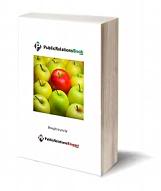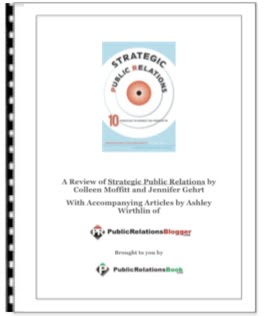________________________________________________________________________
 Stripped down to its core, publicity is little more than one person persuading another. You, the publicity seeker, must persuade a journalist that your story is worthy of receiving print space or air time. Your ability to sell your story to a journalist is what it's all about.
Stripped down to its core, publicity is little more than one person persuading another. You, the publicity seeker, must persuade a journalist that your story is worthy of receiving print space or air time. Your ability to sell your story to a journalist is what it's all about.
If you've ever sat with an insurance salesman who droned on and on, you probably know that simpler is better when it comes to persuasion. A few choice words, a brief, well-reasoned argument and a strong close can make the sale. Too much detail, too much rambling and too much pontification can kill a deal.
When pitching a journalist, the same rules apply, Keep your pitch short and to the point -- and the results will come.
Unfortunately, many beginning publicity seekers -- and even some old pros -- forget this advice. Instead of keeping things short, they seek to overwhelm journalists with multi-page press releases, extensive backgrounders and lengthy fact sheets. If they even get read (and most just go directly to the trash) these voluminous press kits only serve to bury your main argument in a blizzard of verbiage.
That's why I love pitch letters.
A pitch letter is a brief business letter, almost never longer than one page. It can accompany a press release, or it can stand on its own. Pitch letters serve one purpose -- to pique the journalist's interest in your story. They needn't tell the whole story. Rather, they are "teasers" for the meat of your story angle. If you've hooked the journalist with your pitch letter, you have a real chance of getting the rest of your press materials read -- and your story placed.
Pitch letters can be sent by snail mail but, increasingly, they're the perfect tool for e-mail contact. Too many publicity seekers send entire press releases by e-mail when a few brief paragraphs would serve their cause far better.
If you're e-mailing a pitch letter to a journalist there are three rules to follow:
1. Keep it short. Try to limit your pitch to two or three paragraphs.
2. Never send attachments. In this era of worms and viruses, that's bad netiquette.
3. Take the time to craft a short, snappy headline. You don't have to tell your story in the headline -- just make it intriguing enough for the journalist to click "open", not "delete"
Whether your sending it on paper or electronically, here's how to put together a strong pitch letter, step-by-step:
* Start off with your best shot
In the first sentence, try to give the reporter something that will make him say either "Gee, I never knew that" or "That's an interesting angle for a story". Or better yet, try to get him to say both things! Don't mess around with formalities, and don't bury your angle in hype. Here's an example of a pitch letter we used to promote "the world's largest game of Pictionary":
Mr. Joe Smith Features Editor The Daily Herald Anytown, OH 44444
Dear Mr. Smith:
On November 19, during halftime of the California- Stanford game, 80,000 people will make history.
They'll be helping to establish a New World Record by participating in the largest participatory game in history -- a monumental round of Pictionary, led by the Stanford Marching Band.
Straight to point and no nonsense. Just the way a reporter wants it.
Here's another example -- one that fits the "Gee, I didn't know that" category. It's to promote the national winner of a contest sponsored by one of our clients:
Dear Mr. Smith:
A miracle has bloomed and is now being harvested in the heart of the South Bronx.
What used to be a trash-filled vacant lot covered with used hypodermic needles and crack vials is now a spectacular 2 1/2-acre working farm. Every day, under the watchful eye of Garden Director and seasoned gardener Jack O'Connor, dozens of neighborhood youngsters come to tend their garden plots, sing songs, hear poetry and learn about nature. Jack has only one rule of thumb: Before the fun starts, the day's schoolwork must be completed.
* Target your pitch
Even if you have only one version of a press release, you can still target your pitch to a particular media outlet by crafting a specific pitch letter. The purpose of the pitch letter in this case -- to frame the story in a way that makes it clear to the journalist that it fits in with that media outlet's approach.
Here's a letter we wrote to The Paul Harvey Show to pitch the story behind one of our clients, a board game company called The Games Gang. It resulted in a story on Mr. Harvey's show -- one of the biggest publicity hits you can get.
Notice that it's written in a structure and style similar to what you might hear on The Paul Harvey Show. We also played up the "senior" status of the Games Gang members, as senior citizens make up a significant portion of their listenership.
Here's the letter:
Mr. John Smith Producer "The Paul Harvey Show" Anytown, OH 44444
Dear John,
In June, 1986, a group of veteran toy sales people (average age: 60) were told there was no more room for them at the company they'd served for more than 30 years.
They didn't slip quietly into retirement, however. Instead, they set out to prove the toy industry wrong -- to show that experience and commonsense are the keys to success.
They've done it.
The company they formed, The Games Gang, has taken the games industry by storm. They've beaten the odds by creating one of the most successful games in American history -- Pictionary -- and following it up with another hit, Balderdash. Today, 10 million games later, the "Over The Hill Gang" is at the top of the game heap, having surpassed their larger -- and younger -- rivals.
We think your listeners and readers, especially those who feel as if their best days are behind them, will find the story of The Games Gang a real inspiration. We hope you agree.
I'll be in touch soon.
Sincerely,
Bill Stoller
* Show how your story relates to the reporter's audience
Did you catch this line in the Paul Harvey pitch letter?
"We think your listeners and readers, especially those who feel as if their best days are behind them, will find the story of The Games Gang a real inspiration."
That's the line that probably put the story over the top. We took what was essentially a corporate story and demonstrated that it could have meaning to a wide group of listeners -- even those who don't play board games or care about entrepreneurs.
Try to find a bigger theme in your story, especially one that fits with the mission of the media outlet you're pitching.
Pitch letters are wonderful and often underused tools. Just keep them short, get to the point, try to show how your story can appeal to a wide audience and, where appropriate, have a little fun, and you'll be pitching like a pro!
Bill Stoller, the "Publicity Insider", has spent two decades as one of America's top publicists. Now, through his website, eZine and subscription newsletter, Free Publicity: The Newsletter for PR-Hungry Businesses, he's sharing -- for the very first time -- his secrets of scoring big publicity. For free articles, killer publicity tips and much, much more, visit Bill's exclusive new site.
Article Source.
Tags: tips to pitching, public relations pitch, PR
Tips on Being a Professional Public Relations Pitcher
________________________________________
 Stripped down to its core, publicity is little more than one person persuading another. You, the publicity seeker, must persuade a journalist that your story is worthy of receiving print space or air time. Your ability to sell your story to a journalist is what it's all about.
Stripped down to its core, publicity is little more than one person persuading another. You, the publicity seeker, must persuade a journalist that your story is worthy of receiving print space or air time. Your ability to sell your story to a journalist is what it's all about.If you've ever sat with an insurance salesman who droned on and on, you probably know that simpler is better when it comes to persuasion. A few choice words, a brief, well-reasoned argument and a strong close can make the sale. Too much detail, too much rambling and too much pontification can kill a deal.
When pitching a journalist, the same rules apply, Keep your pitch short and to the point -- and the results will come.
Unfortunately, many beginning publicity seekers -- and even some old pros -- forget this advice. Instead of keeping things short, they seek to overwhelm journalists with multi-page press releases, extensive backgrounders and lengthy fact sheets. If they even get read (and most just go directly to the trash) these voluminous press kits only serve to bury your main argument in a blizzard of verbiage.
That's why I love pitch letters.
A pitch letter is a brief business letter, almost never longer than one page. It can accompany a press release, or it can stand on its own. Pitch letters serve one purpose -- to pique the journalist's interest in your story. They needn't tell the whole story. Rather, they are "teasers" for the meat of your story angle. If you've hooked the journalist with your pitch letter, you have a real chance of getting the rest of your press materials read -- and your story placed.
Pitch letters can be sent by snail mail but, increasingly, they're the perfect tool for e-mail contact. Too many publicity seekers send entire press releases by e-mail when a few brief paragraphs would serve their cause far better.
If you're e-mailing a pitch letter to a journalist there are three rules to follow:
1. Keep it short. Try to limit your pitch to two or three paragraphs.
2. Never send attachments. In this era of worms and viruses, that's bad netiquette.
3. Take the time to craft a short, snappy headline. You don't have to tell your story in the headline -- just make it intriguing enough for the journalist to click "open", not "delete"
Whether your sending it on paper or electronically, here's how to put together a strong pitch letter, step-by-step:
* Start off with your best shot
In the first sentence, try to give the reporter something that will make him say either "Gee, I never knew that" or "That's an interesting angle for a story". Or better yet, try to get him to say both things! Don't mess around with formalities, and don't bury your angle in hype. Here's an example of a pitch letter we used to promote "the world's largest game of Pictionary":
Mr. Joe Smith Features Editor The Daily Herald Anytown, OH 44444
Dear Mr. Smith:
On November 19, during halftime of the California- Stanford game, 80,000 people will make history.
They'll be helping to establish a New World Record by participating in the largest participatory game in history -- a monumental round of Pictionary, led by the Stanford Marching Band.
Straight to point and no nonsense. Just the way a reporter wants it.
Here's another example -- one that fits the "Gee, I didn't know that" category. It's to promote the national winner of a contest sponsored by one of our clients:
Dear Mr. Smith:
A miracle has bloomed and is now being harvested in the heart of the South Bronx.
What used to be a trash-filled vacant lot covered with used hypodermic needles and crack vials is now a spectacular 2 1/2-acre working farm. Every day, under the watchful eye of Garden Director and seasoned gardener Jack O'Connor, dozens of neighborhood youngsters come to tend their garden plots, sing songs, hear poetry and learn about nature. Jack has only one rule of thumb: Before the fun starts, the day's schoolwork must be completed.
* Target your pitch
Even if you have only one version of a press release, you can still target your pitch to a particular media outlet by crafting a specific pitch letter. The purpose of the pitch letter in this case -- to frame the story in a way that makes it clear to the journalist that it fits in with that media outlet's approach.
Here's a letter we wrote to The Paul Harvey Show to pitch the story behind one of our clients, a board game company called The Games Gang. It resulted in a story on Mr. Harvey's show -- one of the biggest publicity hits you can get.
Notice that it's written in a structure and style similar to what you might hear on The Paul Harvey Show. We also played up the "senior" status of the Games Gang members, as senior citizens make up a significant portion of their listenership.
Here's the letter:
Mr. John Smith Producer "The Paul Harvey Show" Anytown, OH 44444
Dear John,
In June, 1986, a group of veteran toy sales people (average age: 60) were told there was no more room for them at the company they'd served for more than 30 years.
They didn't slip quietly into retirement, however. Instead, they set out to prove the toy industry wrong -- to show that experience and commonsense are the keys to success.
They've done it.
The company they formed, The Games Gang, has taken the games industry by storm. They've beaten the odds by creating one of the most successful games in American history -- Pictionary -- and following it up with another hit, Balderdash. Today, 10 million games later, the "Over The Hill Gang" is at the top of the game heap, having surpassed their larger -- and younger -- rivals.
We think your listeners and readers, especially those who feel as if their best days are behind them, will find the story of The Games Gang a real inspiration. We hope you agree.
I'll be in touch soon.
Sincerely,
Bill Stoller
* Show how your story relates to the reporter's audience
Did you catch this line in the Paul Harvey pitch letter?
"We think your listeners and readers, especially those who feel as if their best days are behind them, will find the story of The Games Gang a real inspiration."
That's the line that probably put the story over the top. We took what was essentially a corporate story and demonstrated that it could have meaning to a wide group of listeners -- even those who don't play board games or care about entrepreneurs.
Try to find a bigger theme in your story, especially one that fits with the mission of the media outlet you're pitching.
Pitch letters are wonderful and often underused tools. Just keep them short, get to the point, try to show how your story can appeal to a wide audience and, where appropriate, have a little fun, and you'll be pitching like a pro!
Bill Stoller, the "Publicity Insider", has spent two decades as one of America's top publicists. Now, through his website, eZine and subscription newsletter, Free Publicity: The Newsletter for PR-Hungry Businesses, he's sharing -- for the very first time -- his secrets of scoring big publicity. For free articles, killer publicity tips and much, much more, visit Bill's exclusive new site.
Article Source.
Tags: tips to pitching, public relations pitch, PR
Popular choices
Subscribe to:
Post Comments (Atom)






Comments (0)
Post a Comment